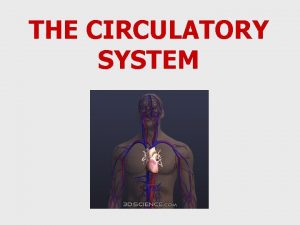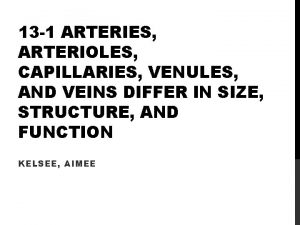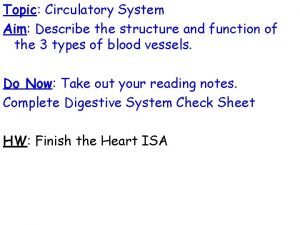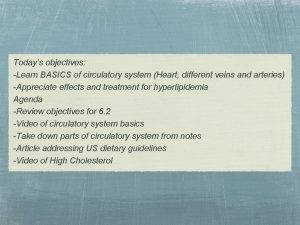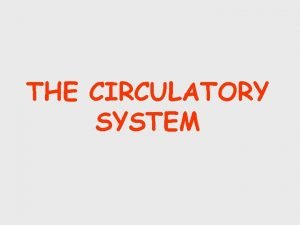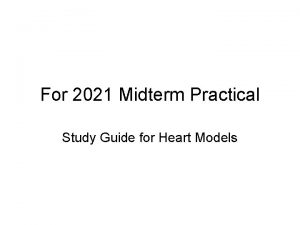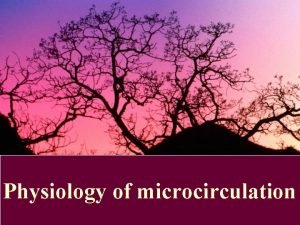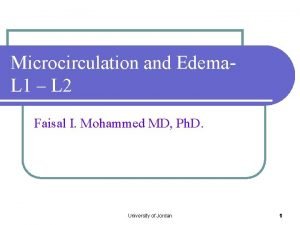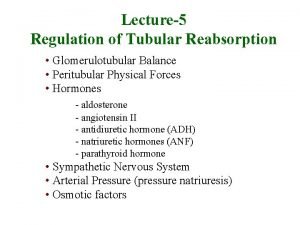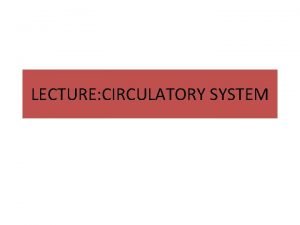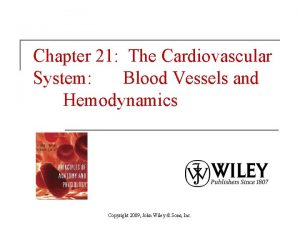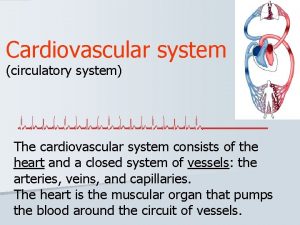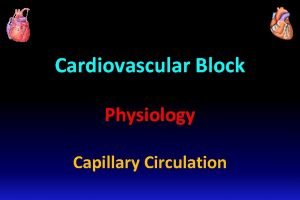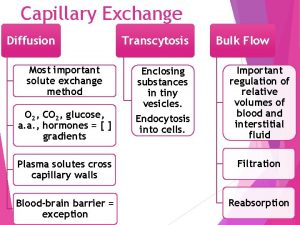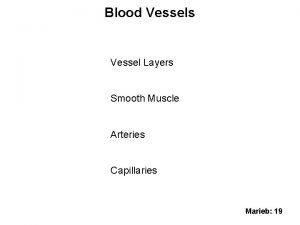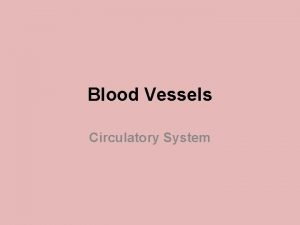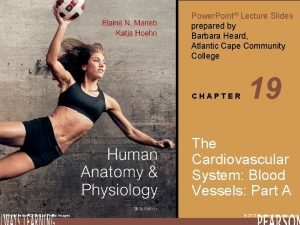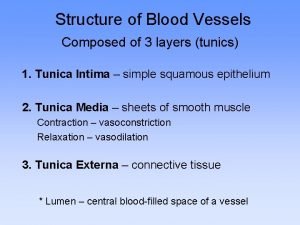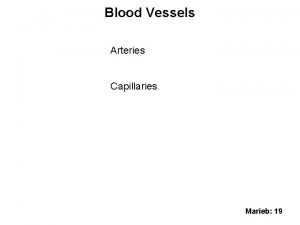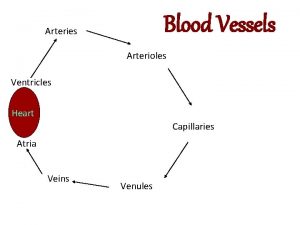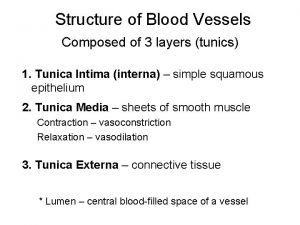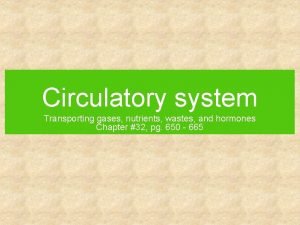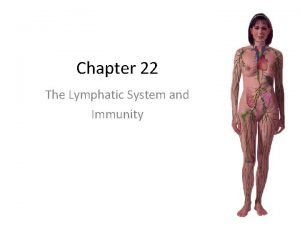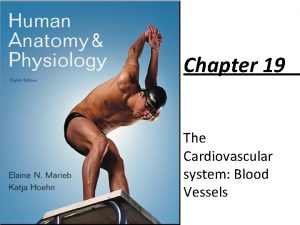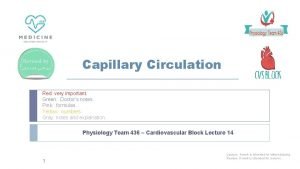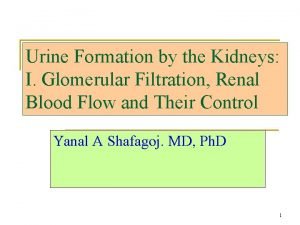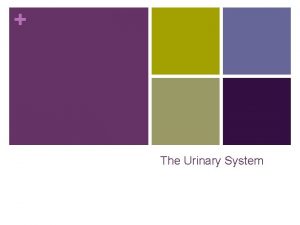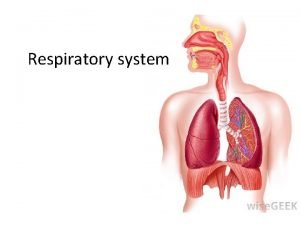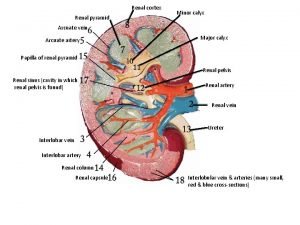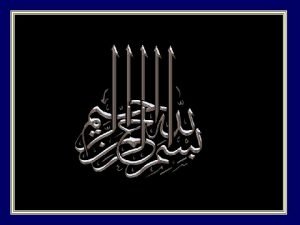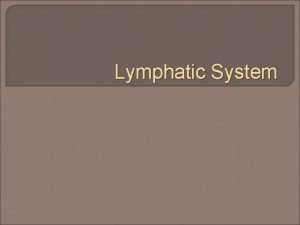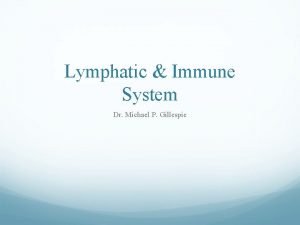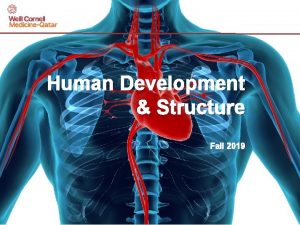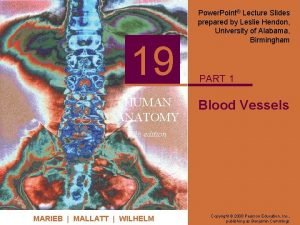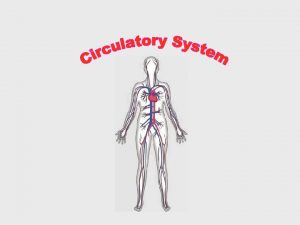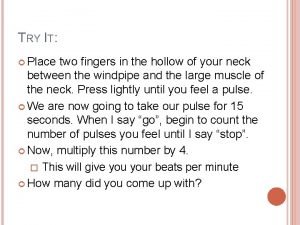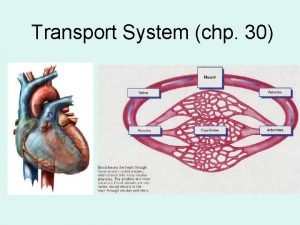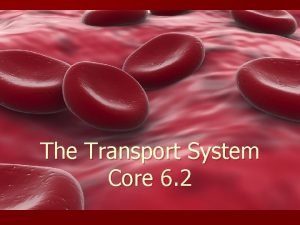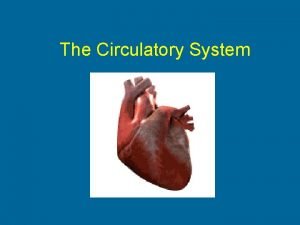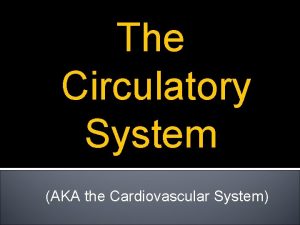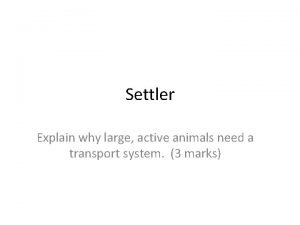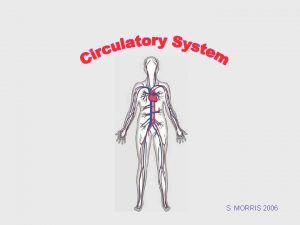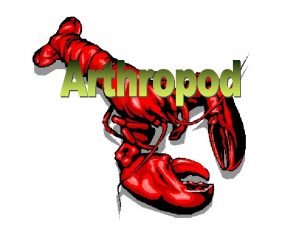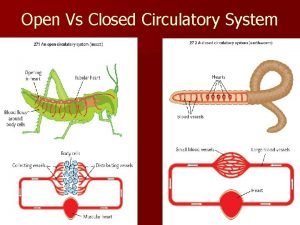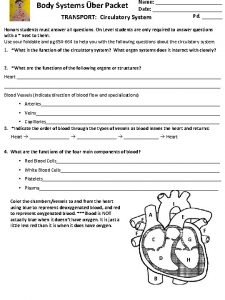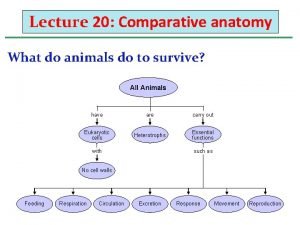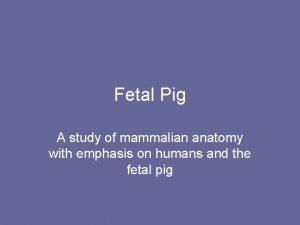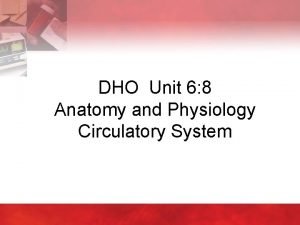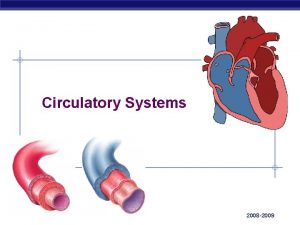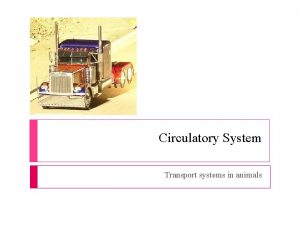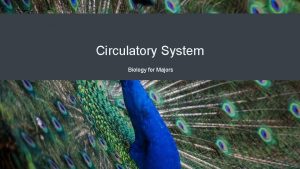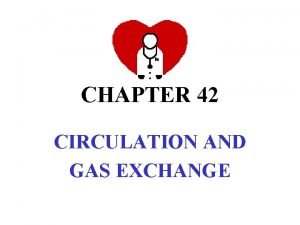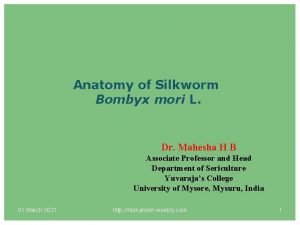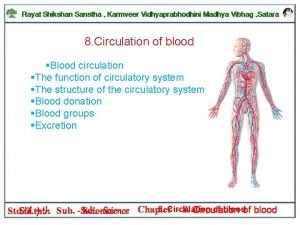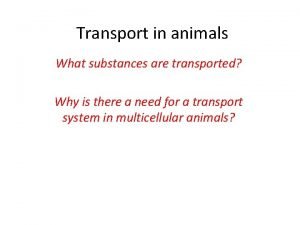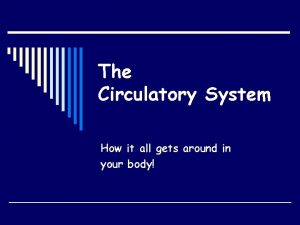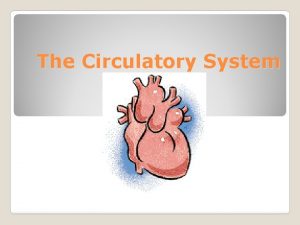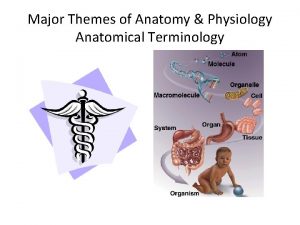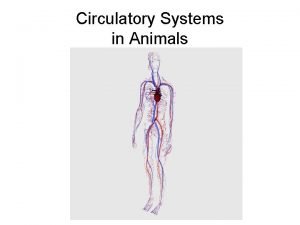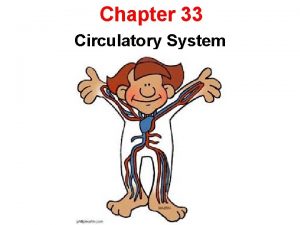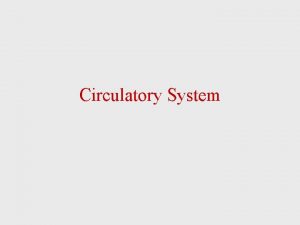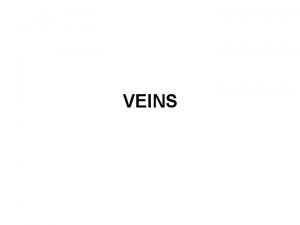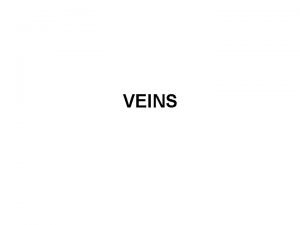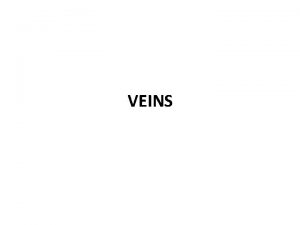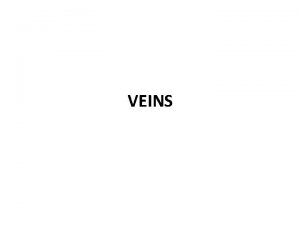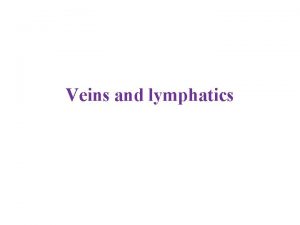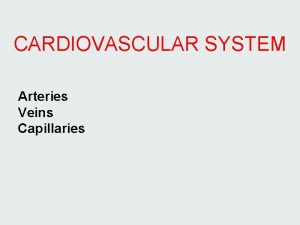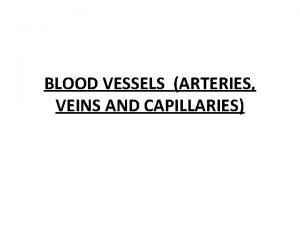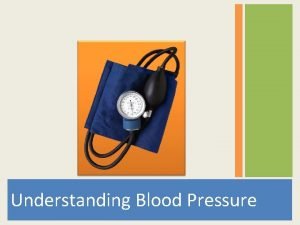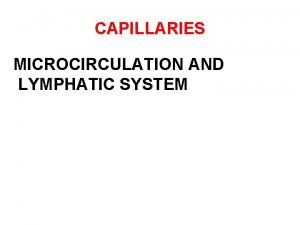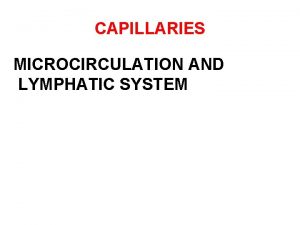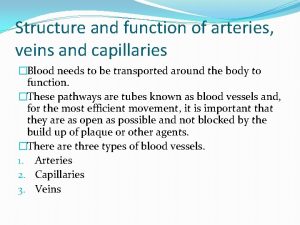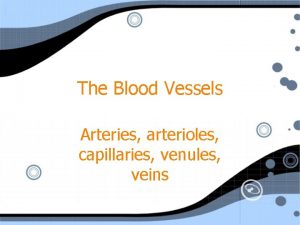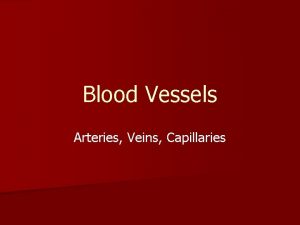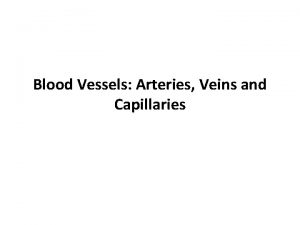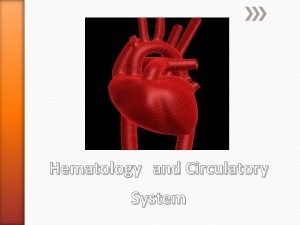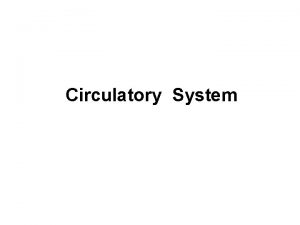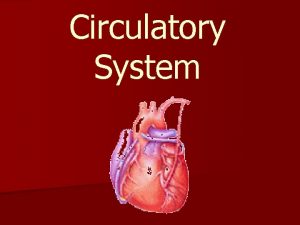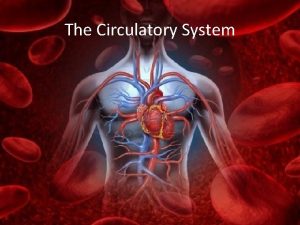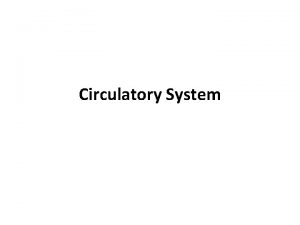THE CIRCULATORY SYSTEM Circulatory System Heart Veins Capillaries


























































































- Slides: 90

THE CIRCULATORY SYSTEM

Circulatory System • Heart • Veins • Capillaries • Arteries

Circulatory System • • Heart Veins Capillaries Arteries

Functions of the circulatory system: • Distribute nutrients • Transport and exchange oxygen and carbon dioxide • Remove waste materials • Distribute secretions of endocrine glands • Prevent excessive bleeding • Prevent infection • Regulate body temperature

Anatomy and Physiology of the Heart • Heart: funnel-shaped, hollow, muscular organ that is responsible for pumping blood to all parts of the body. –Pacemaker: special tissue that controls the heartbeat

• The heart is located near the center of the thoracic cavity between the lungs and is contained in the pericardial sac. • Pericardial Sac: supports the heart and contains some fluid for lubrication.

LAYERS OF THE HEART WALL • Epicardium – outer layer of heart wall • Endocardium – inner layer that consists of endothelial cells, which line the heart, covers the heart valves, and lines the blood vessels • Myocardium – middle layer composed of cardiac muscle

Chambers of the heart • • Left Atrium Right Atrium Left Ventricle Right Ventricle *Left and right sides are separated by the septum

Heart Valves • Opens to allow blood to go from one chamber to another chamber. • Only lets blood flow one direction

Heart Valves • Pulmonary Valve: from the R. Ventricle to the lungs • Aortic Valve: from the left L. Ventricle to the aorta • Mitral/Tricuspid: from the atria to the ventricles

Veins & Arteries • Upper/Lower Vena Cava: brings blood to the heart • Pulmonary Vein: brings blood from the lungs to the heart • Pulmonary Artery: blood from heart to lungs • Aorta: blood from heart to the body – Largest vessel in our body


VASCULAR SYSTEM • The vascular system is made up of three types of blood vessels: – Arteries – Capillaries – Veins

Blood Vessels Photo from U. S. Federal Government courtesy of Wikipedia.

ARTERIES • BLOOD VESSELS THAT CARRY BLOOD, RICH IN OXYGEN, FROM THE HEART TO OTHER PARTS OF THE BODY – THICK WALLS – ELASTIC TISSUE – “A”RTERY = “A”WAY from heart – NARROW OPENING

ARTERIES • Arteries branch into smaller vessels called Arterioles • Arterioles branch into smaller vessels called Capillaries

CAPILLARIES • Capillaries – So small only one blood cell wide – This is where O 2 , water, nutrients and wastes are exchanged – Connects arteries to veins

VEINS • Blood vessels that return blood to the heart from all parts of the body. – Have thin walls – Are collapsible

Capillary Bed Interaction of molecules flowing in and out of blood at a capillary bed.

Parts of the Circulatory System The total circulatory system is divided into two main parts: • Pulmonary circulation, and • Systemic circulation.

Pulmonary Circulation System Red portion of heart and red blood vessels carry oxygen-rich blood. Blue portion of heart and blue blood vessels carry oxygen-poor blood.

PULMONARY CIRCULATION • Takes the blood from the heart to the lungs, where it is oxygenated, and it returns it to the heart.

SYSTEMIC CIRCULATION • The flow of oxygenated blood from the heart to the cells in all parts of the body, and return of unoxygenated blood back to the heart. THE END

The Flow of Blood Through the Systemic Circulatory System Oxygenated blood leaves the left ventricle of the heart through the aorta, the largest artery in the body.

The left and right coronary arteries immediately branch from the aorta and carry fresh blood to the heart muscle itself. The coronary veins quickly return that blood back to the heart.

A heart attack often involves a clot in the coronary arteries or their branches. In this illustration, a clot is shown in the location of #1. Area #2 shows the portion of the damaged heart that is affected by the clot. Image by J. Heuser courtesy of Wikipedia.

The brachiocephalic trunk is the next branch from the aorta. The carotid arteries branch off the brachiocephalic trunk and carry oxygenated blood to the neck and head region. Blood from the neck and head region returned by the jugular veins.

The left and right brachial arteries also branch from the brachiocephalic trunk to supply blood to the shoulders and forelegs.

The thoracic aorta refers to the portion of the aorta that goes from the heart, through the thoracic cavity to the diaphragm. The portion of the aorta that goes from the diaphragm, through the abdominal region, to the last lumbar vertebrae is called the abdominal aorta.

Branches from the thoracic aorta supply oxygenated blood to the lungs (via bronchial arteries), esophagus, ribs and diaphragm. The celiac artery branches from the aorta immediately past the diaphragm and itself branches into the gastric, splenic, and hepatic arteries.

The gastric artery supplies blood to the stomach. The splenic artery supplies blood to the spleen. The hepatic artery supplies blood to the liver.

The cranial and caudal mesenteric arteries branch from the abdominal aorta and carry blood to the small and large intestines. The renal arteries are next to branch from the abdominal aorta.

The renal arteries have two important functions: • supply blood to the kidneys, and • carry large volumes of blood to the kidneys for filtration and purification.

From the renal arteries arise arteries that supply blood to the testicles in males (internal spermatic arteries) and parts of the reproductive system in females (uteroovarian arteries).

The abdominal aorta ends where it branches into the internal and external iliac arteries. The internal iliac artery supplies blood to the pelvic and hip region. The external iliac artery branches into the femoral arteries.

The femoral arteries and their branches supply oxygenated blood to the hind legs.

Veins normally accompany arteries and often have similar names. Veins are always larger than the arteries and are sometimes more visible than arteries because they are closer to the skin surface. Most veins eventually empty the unoxygenated blood into the vena cavas.

The cranial veins return the blood from the head, neck, forelegs, and part of the thoracic cavity to the right atrium of the heart via the superior vena cava. These cranial veins include the jugular vein, brachial veins, internal thoracic veins, and the vertebral veins.

The caudal veins return blood from the iliac, lumbar, renal, and adrenal veins to the right atrium of the heart via the inferior vena cava. Before blood is returned to the heart from the stomach, pancreas, small intestine, and spleen, it goes through the liver for filtration.

This portion of the systemic system is known as the hepatic portal system. The gastric vein (stomach), splenic vein (spleen), pancreatic vein (pancreas), and mesenteric veins (small intestines) empty into the portal vein that carries the blood to the liver.

In the liver, the portal vein branches into smaller venules and finally into capillary beds. In the capillary beds of the liver, nutrients are exchanged for storage and the blood is purified. The capillaries then join into venules that empty into the hepatic vein, which carries blood to the inferior (caudal) vena cava.

Photo from Wikepedia. Liver of a sheep: (1) right lobe, (2) left lobe, (3) caudate lobe, (4) quadrate lobe, (5) hepatic artery and portal vein, (6) hepatic lymph nodes, (7) gall bladder.

Anatomy and Physiology of the Lymphatic System The lymphatic system is part of the immune system and acts as a secondary (accessory) circulatory system.

Functions of the lymphatic system: • remove excess fluids from body tissues, • absorb fatty acid and transport fat to circulatory system, and • produce immune cells (lymphocytes, monocytes, and plasma cells).

Blood fluid escapes through the thin-walled capillaries into spaces between body tissue cells. Lymph vessels, which have very thin walls, pick up these fluids called lymph.

Flow of Blood & Lymph Within Tissue

The lymph vessels join to form larger ducts that pass through lymph nodes (or glands). Each lymph node has a fibrous outer covering (capsule), a cortex, and a medulla.

Photo from U. S. Federal Government courtesy of Wikipedia.

Lymph nodes filter foreign substances, such as bacteria and cancer cells, from the lymph before it is re-entered into the blood system through the larger veins. Lymph nodes, which are scattered among the lymph vessels, act as the body’s first defense against infection.

Lymph nodes produce the following cells: • Lymphocytes – a type of white blood cell, • Monocytes – a leukocyte that protects against blood-borne pathogens, and • Plasma cells – produce antibodies.

Each lymph node has its own blood supply and venous drainage. The lymph nodes usually have names that are related to their location in the body.

When a specific location gets infected, the lymph nodes in that area will enlarge to fight the infection. If the lymph node closest to an infected area is unable to eliminate the infection, other lymph nodes in the system will attempt to fight the infection.

This is particularly critical in the case of cancer, which can be spread from its point of origin to all parts of the body through the lymphatic system.

Anatomy and Physiology of the Blood is an important component of the circulatory system. Anatomically and functionally, blood is a connective tissue.

The amount of blood that a domestic animal has is expressed in terms of percentage of body weight. EXPECTED VOLUME OF BLOOD IN DOMESTIC ANIMALS Domestic Animal % of Body Weight Cattle Sheep 7. 7 % 8. 0% Horses 9. 7%

Components of Blood

Plasma, which makes up 50 – 65% of the total volume of blood, is a straw-colored liquid containing water (90%) and solids (10%). The solids in plasma include inorganic salts and organic substances such as antibodies, hormones, vitamins, enzymes, proteins, and glucose (blood sugar).

The non-plasma, or cellular, portion of blood is composed of red blood cells, white blood cells, and platelets. From left to right: Red blood cell (erythrocyte); Platelet (thrombocyte); White blood cell (leukocyte). Photo from U. S. Federal Government courtesy of Wikipedia.

Red blood cells, called erythrocytes, are responsible for carrying oxygen from the lungs to various body tissues. Red blood cells contain hemoglobin, which gives them their characteristic red color and helps them carry the oxygen.

Red blood cells are biconcave discs, a shape that provides a large area for oxygen exchange.

Red blood cells are produced in the red marrow of bones.

Most domestic animals have a red blood cell count of seven million cells per cubic millimeter of blood. Red blood cells will last from 90 to 120 days and are removed from the blood by the spleen, liver, bone marrow, or lymph nodes when they are worn out.

Anemia is a condition caused by low levels of red blood cells and hemoglobin. Anemia can be caused by the following: • Loss of blood due to injury, • Infestations of blood-sucking parasites, or • Low levels of red cell production due to poor nutrition.

Hemoconcentration is a condition in which there is an above normal level of red blood cells. Hemoconcentration is normally caused by dehydration (loss of body fluid), which can be the result of vomiting, diarrhea, or any chronic disease characterized by high body temperatures.

Blood platelets, or thrombocytes, are oval-shaped discs that are formed in the bone marrow. Blood platelets help prevent blood loss from injuries to blood vessels by forming clots (white thrombus).

Platelets may secrete a substance that causes the clot to contract and solidify. Platelets may also secrete a substance that causes an injured vessel to constrict at the injury.

White blood cells, or leukocytes, are divided into two general categories: • Granulocytes, and • Agranulocytes.

Granulocytes are the category of leukocytes that contain granules within the cytoplasm. Granulocytes include: • Neutrophils, • Eosinophils, and • Basophils.

Neutrophils – produced by bone marrow, neutrophils fight disease by migrating to the point of infection, absorbing bacteria, and destroying them. Neutrophil (purple) migrating through tissue to engulf bacteria through phagocytosis. Neutrophils dissolve dead tissue resulting in a semi-liquid material called pus. Courtesy of Wikipedia. Abscess – a concentrated area of pus.

Eosinophils - a type of granulocyte that plays a role in combating infection by parasites, as well as, impacting allergies and asthma. They contain most of the histamine protein in the blood, which is an indication of allergic reaction when elevated. Images courtesy of Wikipedia.

Basophils – rare granulocytes that are responsible for the symptoms of allergies, including inflammation. Basophils Image courtesy of Wikipedia.

Agranulocytes are the category of leukocytes that contain very little, if any, granules. Agranulocytes are produced by the lymph nodes, spleen, thymus, and other lymphoid tissue.

There are two types of agranulocytes: • Lymphocytes, and • Monocytes.

Lymphocytes – agranulocytes that produce and release antibodies at site of infections to fight disease. Lymphocytes also produce antibodies that allow an animal to build up immunities to a particular disease. Image from U. S. Federal Government courtesy of Wikipedia.

Monocytes are agranulocytes that absorb disease-producing materials, such as bacteria that cause tuberculosis, through phagocytosis. Unlike neutrophils, monocytes do not produce pus. Image courtesy of Wikipedia. Monocytes join body tissue to form larger, disease-absorbing masses called macrophages.


In domestic animals, approximately 85% to 90% of the leukocytes in domestic mammals are neutrophils and lymphocytes. The total number of neutrophils and lymphocytes are about equal, but temporary stress increases the ratio of neutrophils to lymphocytes until that stress is removed.

When bacterial infections occur, the number of white blood cells normally increases. When viral infections occur, the number of white blood cells normally decreases. Therefore, the concentration of white blood cells can help diagnose disease.

Blood clotting is called coagulation and is important in reducing blood loss caused by injury and in healing the injury.

Fibrin is a thread-like mass produced by fibrinogen (fibrous protein in blood) and thrombin. Fibrin holds the red blood cells, white blood cells, and platelets together to form a blood clot.

White Cell Counts and Coagulation Times for Domestic Animals Species Normal White Cell Count Coagulation Time ( Per Cubic Millimeter) Cattle 9, 000 6 ½ Minutes Swine 15, 000 3 ½ Minutes Sheep 8, 000 2 ½ Minutes Horses 9, 000 11 ½ Minutes

Vitamin K helps maintain Antithromboplastin and antithrombin, which are two substances that prevent blood from clotting within the circulatory system.

Blood types are classified based on certain antigens and antibodies found on surface of red blood cells. For example, in humans there a total of 29 blood group systems based on antigens on the surface of the red blood cells, but the ABO and Rhesus factor (positive or negative) are the commonly used groups to determine blood type.

Human ABO Blood Types Image courtesy of Wikipedia.

Young animals can receive certain antibodies from their mothers. These antibodies must be passed on to the young animal through the colostrum milk because the placental membrane is fairly impermeable.

When two different blood types, an antigen and its antibody, combine as a result of mating, the reaction would cause agglutination or the clumping together of red blood cells. This may cause some deaths during the early embryonic development in animals.

Many blood types and groups have been identified in domestic animals. • Cattle have 9 recognized blood groups; • Horses have 8 recognized blood groups; and • Canine have 13 described groups, but only 8 recognized groups.

Some blood types can cause disease in the offspring of animals. Individual animals and their parents can be identified using blood-typing. Bulls used for commercial artificial insemination must be blood-typed.

Certain blood types may be connected to superior production and/or performance in animals. For example, egg production and hatchability can be improved in chickens and Pork Stress Syndrome (PSS) can be identified in swine.

ALL RIGHTS RESERVED Reproduction or redistribution of all, or part, of this presentation without written permission is prohibited. Instructional Materials Service Texas A&M University 2588 TAMUS College Station, Texas 77843 -2588 http: //www-ims. tamu. edu 2007
 Abo wikipedia
Abo wikipedia Arteries arterioles capillaries venules veins
Arteries arterioles capillaries venules veins Arteries, veins, capillaries
Arteries, veins, capillaries Difference between arteries veins and capillaries
Difference between arteries veins and capillaries Difference between arteries veins and capillaries
Difference between arteries veins and capillaries Heart veins
Heart veins Respiratory system circulatory system digestive system
Respiratory system circulatory system digestive system Tiny air sacs at the end of the bronchioles
Tiny air sacs at the end of the bronchioles Circulatory system and respiratory system work together
Circulatory system and respiratory system work together Sinusoidal capillaries
Sinusoidal capillaries Osmotic pressure vs hydrostatic
Osmotic pressure vs hydrostatic Furesamide
Furesamide Sinusoidal capillaries
Sinusoidal capillaries Vasa recta vs peritubular capillaries
Vasa recta vs peritubular capillaries Peritubular capillaries vs vasa recta
Peritubular capillaries vs vasa recta Types of capillaries
Types of capillaries Sinusoidal capillaries
Sinusoidal capillaries Continuous capillaries
Continuous capillaries Capillaries exchange
Capillaries exchange Most important method of capillary exchange
Most important method of capillary exchange Capillary
Capillary Blood vessels circulatory system
Blood vessels circulatory system Renal columns
Renal columns Blood vesel
Blood vesel Structure of arteries and veins
Structure of arteries and veins Components of lymphatic system
Components of lymphatic system Capilary beds
Capilary beds Peritubular capillaries
Peritubular capillaries Capillaries
Capillaries Types of capillaries
Types of capillaries Arteries of the thorax
Arteries of the thorax Lymph diagram
Lymph diagram Reabsorption
Reabsorption Are capillaries oxygenated or deoxygenated
Are capillaries oxygenated or deoxygenated Chapter 22 lymphatic system and immunity
Chapter 22 lymphatic system and immunity The lymphatic system consists of
The lymphatic system consists of True capillaries
True capillaries Capilary beds
Capilary beds Filtration fraction
Filtration fraction Layers of kidney
Layers of kidney External respiration process
External respiration process Renal cortex
Renal cortex Peritubular capillaries
Peritubular capillaries Lymphatic capillaries are thin-walled closed-ended tubes
Lymphatic capillaries are thin-walled closed-ended tubes Lymphatic capillaries
Lymphatic capillaries Capillaries function
Capillaries function Sinusoidal capillaries
Sinusoidal capillaries Wide leaky capillaries found in bone marrow and spleen.
Wide leaky capillaries found in bone marrow and spleen. Dullness of heart
Dullness of heart Sheep heart diagram
Sheep heart diagram Stars dogs plowhorses and puzzles
Stars dogs plowhorses and puzzles Circulatory system steps in order
Circulatory system steps in order Non vertebrate
Non vertebrate Heart fish
Heart fish Clam open circulatory system
Clam open circulatory system Sheep circulatory system
Sheep circulatory system Circulatory system function
Circulatory system function Closed circulatory system
Closed circulatory system 3 parts of circulatory system
3 parts of circulatory system 3 parts of the circulatory system
3 parts of the circulatory system Double circulatory system
Double circulatory system How circulatory system work
How circulatory system work What makes up the cardiovascular system
What makes up the cardiovascular system Gas exchange oxygen transport
Gas exchange oxygen transport Single vs double circulatory system
Single vs double circulatory system Subphylum
Subphylum Crustaceans characteristics
Crustaceans characteristics Arteries and veins difference
Arteries and veins difference Circulatory system foldable
Circulatory system foldable Invertebrate circulatory system
Invertebrate circulatory system Andometr
Andometr Unit 6:8 circulatory system
Unit 6:8 circulatory system Open circulatory system
Open circulatory system Open circulatory system
Open circulatory system Circulatory system function
Circulatory system function Main function of the circulatory system
Main function of the circulatory system Arthropods circulatory system
Arthropods circulatory system Difference between open and closed circulatory system
Difference between open and closed circulatory system Chapter 34 section 2 the respiratory system
Chapter 34 section 2 the respiratory system Kinetic skull meaning
Kinetic skull meaning Bombyx mori silkworm diagram
Bombyx mori silkworm diagram Function of the circulatory system
Function of the circulatory system Open circulatory system vs closed
Open circulatory system vs closed Circulatory system interactions with other systems
Circulatory system interactions with other systems Function a
Function a Feed forward mechanism
Feed forward mechanism Mouth function in digestion
Mouth function in digestion Amphibian and reptile circulatory system
Amphibian and reptile circulatory system Chapter 33 section 1 the circulatory system
Chapter 33 section 1 the circulatory system Phylum mollusca characteristics
Phylum mollusca characteristics Identify the cell
Identify the cell
